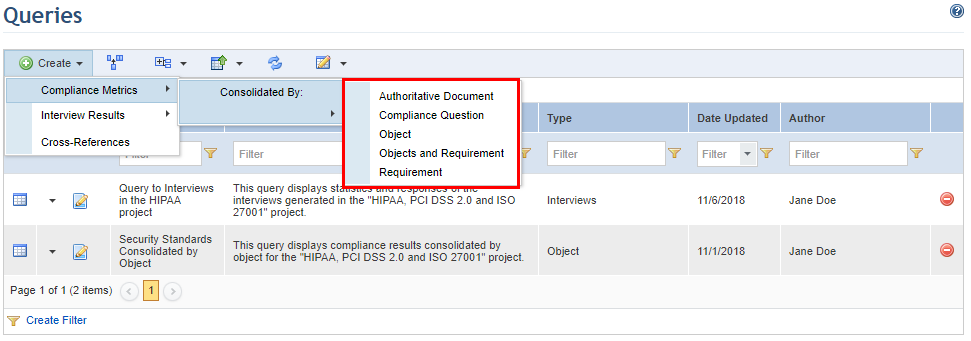
This topic explains how to create and edit queries to consolidate the results of a compliance project, available through the Compliance module. Unlike the Risk module, where indicators for multiple projects can be consolidated, only one project can be selected for the scope of a compliance query.
1. Access the Compliance module.
2. In the Queries section, click the List Queries option.
3. In the Queries section, click Create.
4. Click Compliance Metrics and select Consolidated By.
The system displays the list of objects for which indicators can be consolidated in the query results (see figure below).

For consolidated queries, compliance metrics are always calculated based on the Compliance questions, since this is the most granular object analyzed in a project and is based on which the indicators can be consolidated for higher objects (for example, Compliance question -> requirement -> authoritative document -> asset). The objects by which query results can be consolidated include:
•Authoritative Document: displays a list of indicators for all the authoritative documents analyzed in the project selected.
•Compliance Question: displays a list of indicators for all the Compliance questions (only questions associated with requirements from authoritative documents) analyzed in the project selected.
•Requirement: displays a list of consolidated indicators for each requirement analyzed in the project selected.
•Object: displays a list of indicators for all the objects analyzed in the project selected.
•Object and Requirement: displays a list of indicators for the object/requirement pair analyzed in the project selected.
5. Select the object by which you want to consolidate indicators from the drop-down list.
The system displays the Scope step in the wizard for creating queries, where the compliance project for which consolidated indicators will be displayed in the query results should be selected (see figure below).

6. In the Scope field, select the project you want to use from the combo box.
7. When finished selecting the scope, click Proceed to continue creating the query. If you want to generate the query, click Generate Query. If you want to cancel query creation, click Cancel.
When Proceed is clicked, the system displays the Filters step in the wizard for creating the query, where the filters to be used can be selected (see figure below).
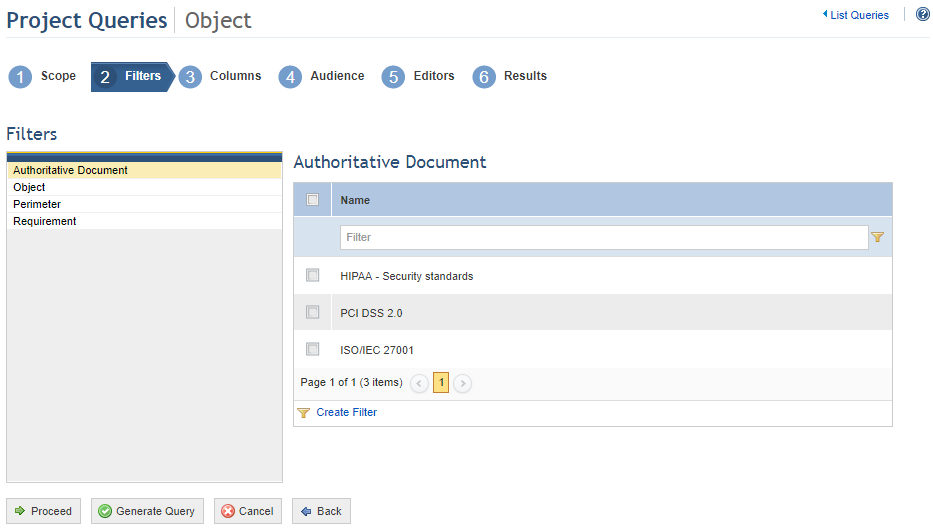
8. Select the filter you want to use by clicking the filter options listed in the list on the left (see figure below).
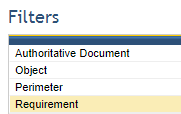
Note: Selecting a filter means reducing the number of responses given to Compliance questions whose consolidated indicators will be displayed in the results. If no filter is selected, all the available indicators for the project selected will be used to consolidate the results. If, for example, you choose to filter by a certain authoritative document in a query to consolidate results by object, only the indicators for the Compliance questions in the interviews related to that document will be used to generate query results.
9. For each filter selected, objects can be added to the filter by clicking Add to Filter (see figure below).
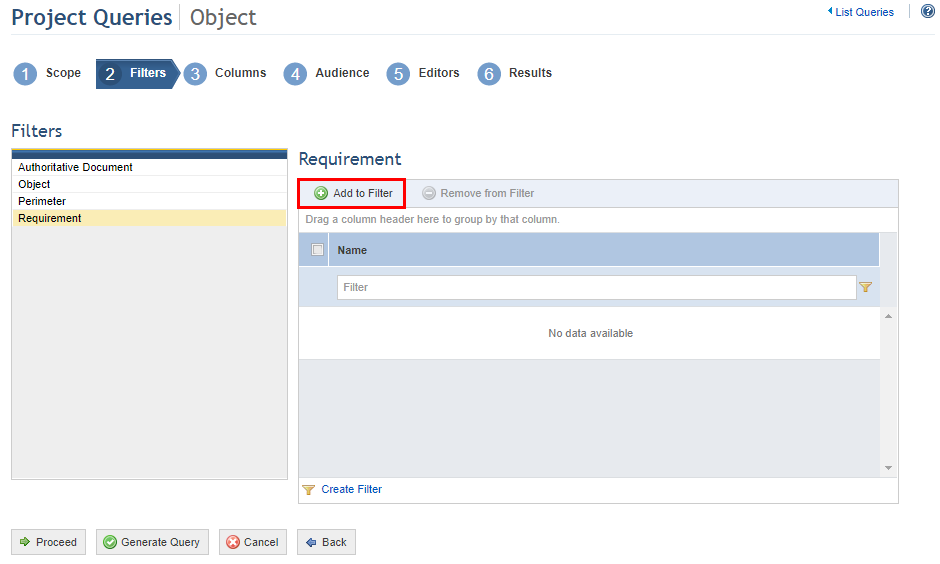
10. Select the objects to be added to the filter in the window that appears and click Add Selected (see figure below). If you want to quit the operation, click Cancel.
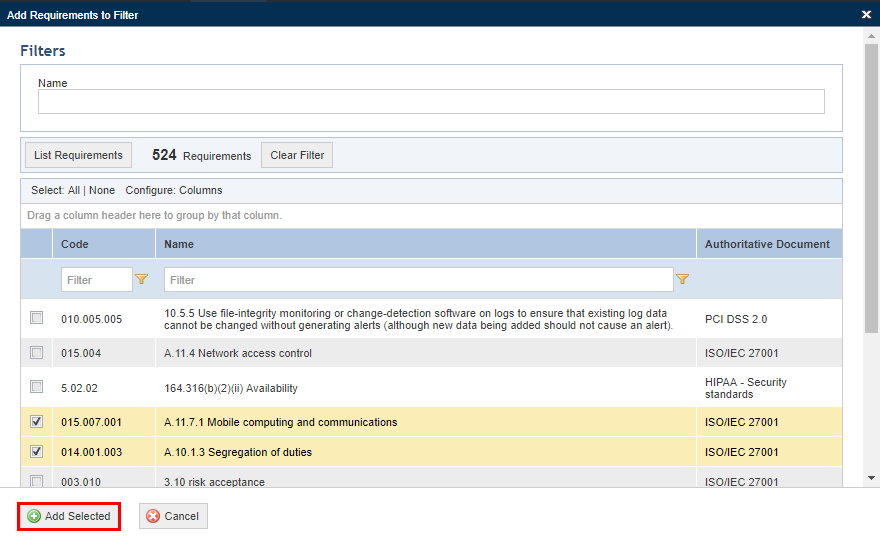
The system displays the objects selected for the filter.
11. To remove objects added to the filter, mark the checkboxes next to each you want to remove and click Remove from Filter.
12. After selecting the filters, click Proceed to continue creating the query. If you want to generate the query, click Generate Query. If you want to cancel query creation, click Cancel. To return to the previous step at any point during this wizard, click Back.
When Proceed is clicked, the system displays the Columns step, where the columns to be displayed in the query results can be selected (see figure below).
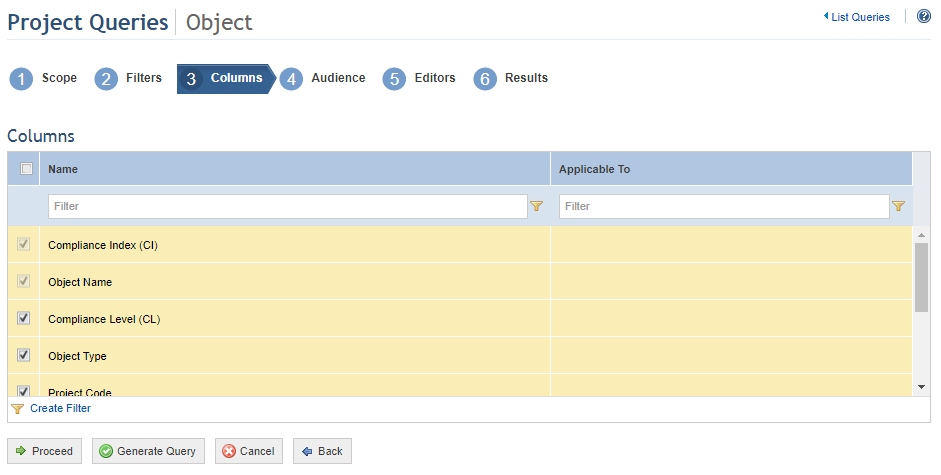
13. Select the columns you want to include in the query by marking the checkboxes next to each option. By default, the system will show some pre-selected options that can be removed, while others are required columns. To include or remove optional columns in the results, simply mark or unmark the checkboxes next to their names.
14. Click Proceed to continue creating the query. If you want to generate the query, click Generate Query. If you want to cancel query creation, click Cancel. To return to the previous step at any point during this wizard, click Back.
When Proceed is clicked, the system displays the Audience step, where you can select which people and groups will be able to view the query in the Home module and in this module, if they have permission to access it (see figure below).
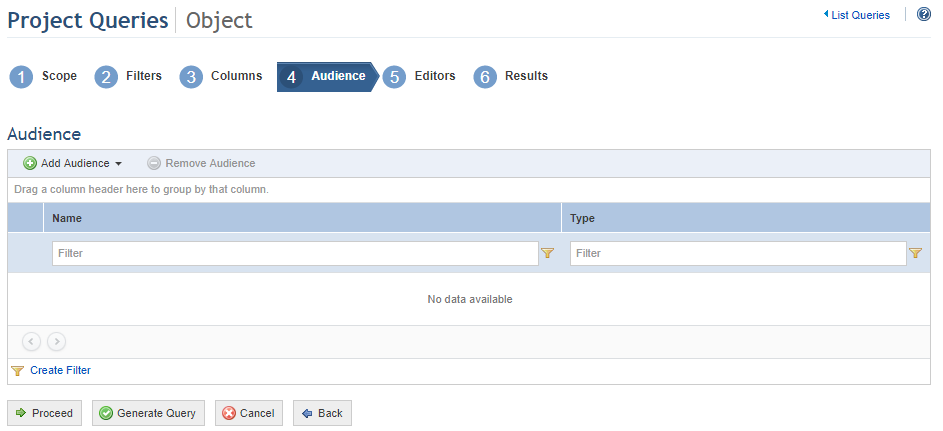
15. Click Add Audience and select People or Groups to add them.
16. If, for example, you selected People, select the people to be added and click Add People (see figure below). If you want to quit the operation, click Cancel.
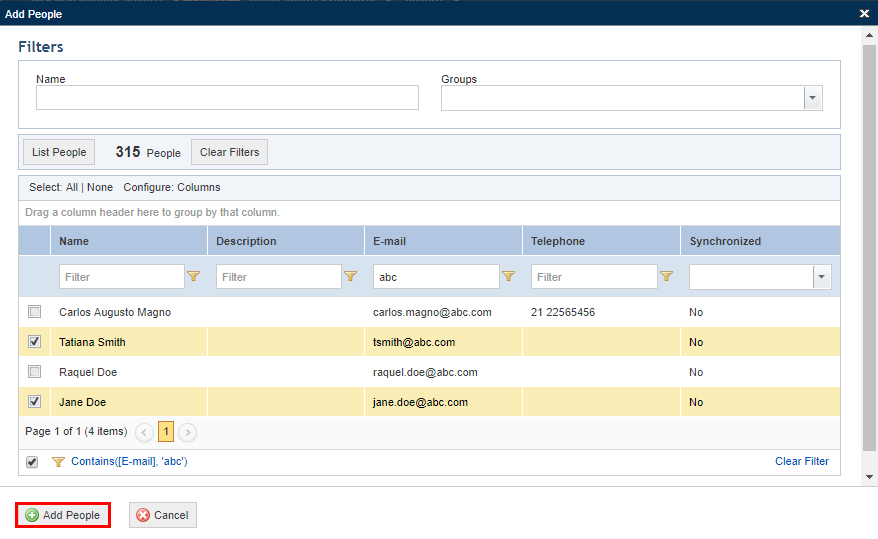
The system displays the people selected.
17. To remove people or groups from the audience, mark the checkboxes next to their names and click Remove Audience.
The system requests confirmation to remove the people or groups from the audience (see figure below).
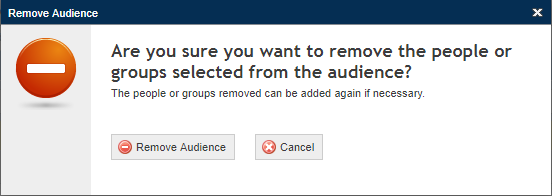
18. Click Remove Audience to confirm. If you want to quit the operation, click Cancel.
The system removes the people selected from the audience.
19. Click Proceed to continue creating the query. If you want to generate the query, click Generate Query. If you want to cancel query creation, click Cancel. To return to the previous step, click Back.
When Proceed is clicked, the system displays the Editors step, where you can select which people and groups will be able to edit the query, receiving the same permissions to it as the author (see figure below).
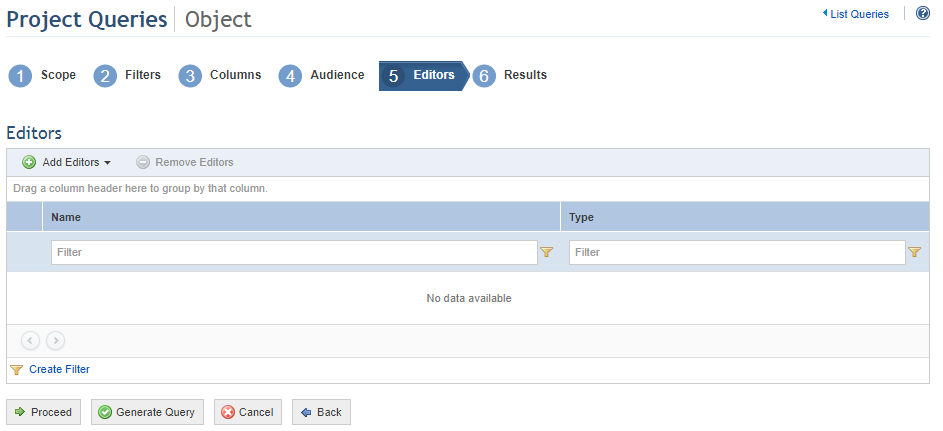
20. Click Add Editors and select People or Groups to add them to the list of editors.
21. If, for example, you selected People, select the people to be added and click Add People (see figure below).

The system displays the people selected.
22. To remove people or groups from the list of editors, mark the checkboxes next to their names and click Remove Editors.
The system requests confirmation to remove the people or groups from the list of editors (see figure below).
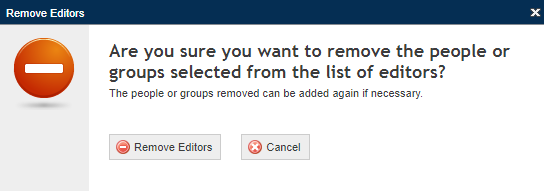
23. Click Remove Editors to confirm. If you want to quit the operation, click Cancel.
The system removes the people selected from the list of editors.
24. Click Proceed or Generate Query to run the query. If you want to cancel query creation, click Cancel. To return to the previous step, click Back.
When Proceed is clicked, the system displays the results of the query according to what was selected in the previous steps (see figure below).
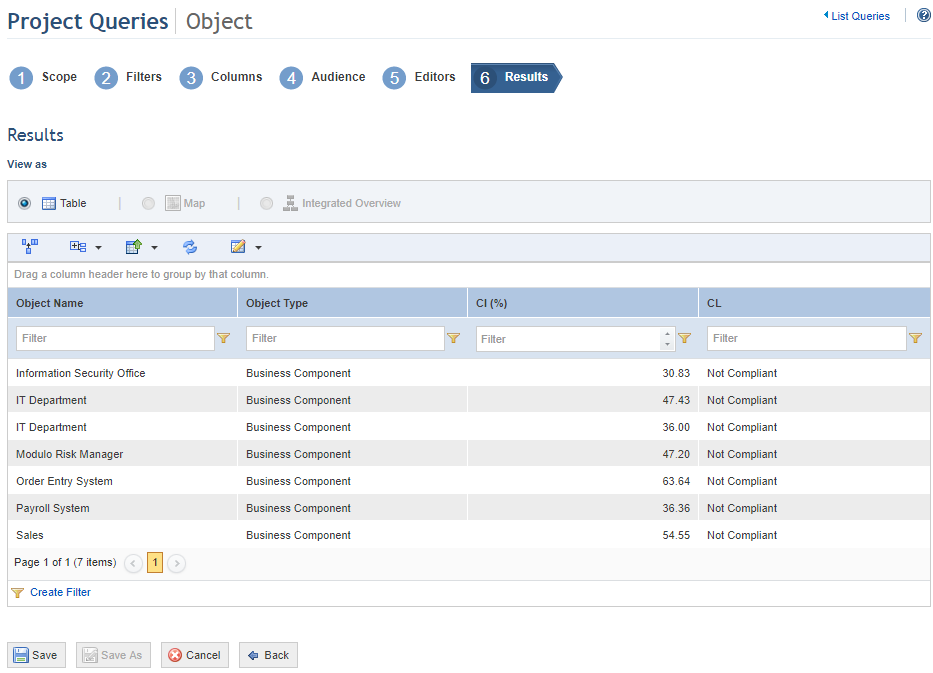
25. Click Save to save the query data. If you do not want to save the query, click Cancel. To return to the previous step, click Back.
When Save is clicked, the system displays a window where a name and description for the query can be entered (see figure below).
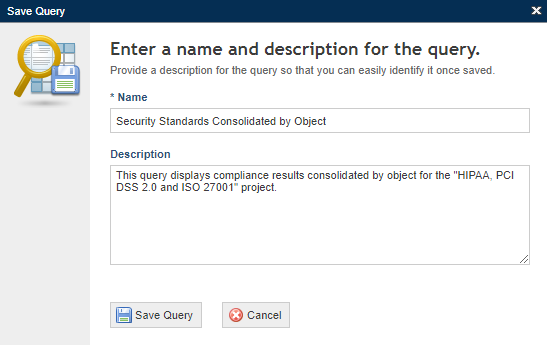
26. In the Name field, enter a name to identify the purpose and reach of the query.
27. In the Description field, enter the main characteristics of the query.
28. When finished, click Save Query. If you want to quit the operation, Cancel.
The system displays a success message.